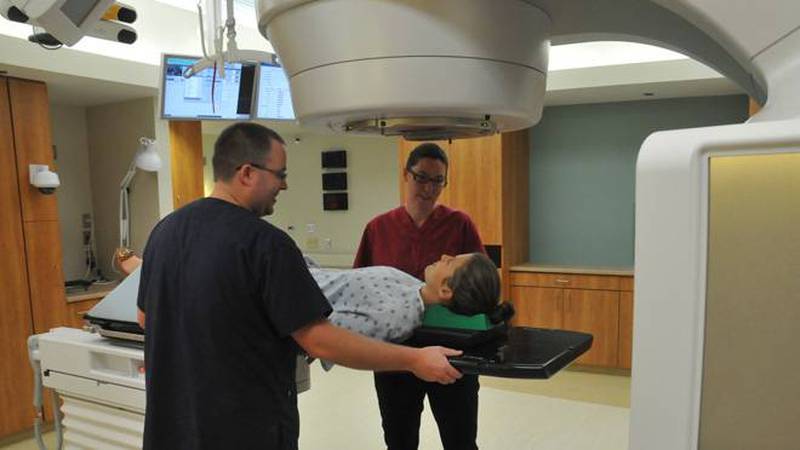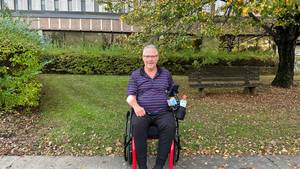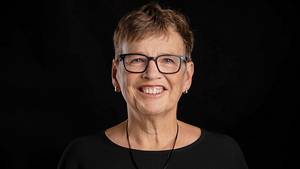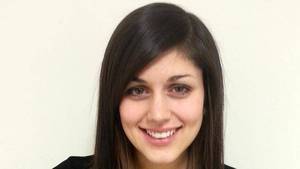Ellen Donahue-Ingraham wasn’t sure what to expect during her first radiation session, so she was surprised to feel like she was part of a science-fiction TV show.
“It’s almost like ‘Beam me up, Scotty,’” laughs Ellen. “It’s so darn accurate and pinpointed that I was only in for 15 minutes. It was fascinating.”
Ellen was one of the very first patients treated in the QEII Health Science Centre’s new James and Edna Claydon Radiation Treatment Clinic, which opened last January at the Victoria General (VG) site.
The $24 million clinic is jointly funded by government and donors to the QEII Foundation's Cancer Never Waits campaign. James and Edna Claydon are leading the campaign with a $1.5 million gift – bringing the total raised to date to $4 million. Originally from Queensport, N.S., Edna graduated from Halifax's former Victoria General Hospital School of Nursing, and worked at the emergency department before moving to Toronto. She still calls Nova Scotia “home,” although she has lived in Ontario for nearly 60 years.
The painters’ tape was still on the walls, and workers were milling around finishing up small tasks, but patients like Ellen were brought into the new space for their treatment as soon as possible.
Dr. Tetteh Ago, QEII’s Chief of Radiation Oncology, says his team eagerly awaited the new space and technology for three years. Donors to the QEII Foundation helped purchase three new linear accelerators that deliver more focused radiation to the cancer site and allow for faster treatment times, meaning 60 additional patients can be treated each day.
“We’re very thrilled and indebted to the people from around the province who sent in heartfelt donations to the program,” says Dr. Ago. “There is a sense of great achievement, not just for those working here, but for everyone in Nova Scotia.
“Because of the tightness with which the new equipment treats the tumor, even those who are not being treated with the new equipment are getting treated sooner. Everyone is benefiting.”
Dr. Ago says only a handful of other hospitals in North America have this specialized radiation equipment, and the QEII has the highest concentration of the equipment.
“We now have two-thirds of our equipment that is able to give the most sophisticated form of treatment,” says Dr. Ago. “It’s terrible to have cancer, but if you do need radiation, the QEII is the place to be.”
After suffering with a persistent cough last winter, Ellen’s family physician sent her for a chest X-ray. The results showed a spot on her right lung, so she was sent for a CT-scan. At that point, Ellen says “everything snowballed.” She had a biopsy and there was talk of surgery to remove the cancer in her two lymph nodes and lower right lung, but a scan showed the cancer had jumped onto one of the lymph nodes on the left side.
“Once it does that, surgery is no longer an option,” says Ellen. “It bumps the cancer to the third stage, so we changed the plan and decided to do an aggressive combination of radiation and chemotherapy.”
Ellen began treatment for non-small cell lung cancer just before Christmas, completing six weeks of radiation and five chemotherapy sessions.
“I was so thrilled when I found out I was one of the first patients to experience the wonderful new facility,” says Ellen. “It’s just amazing. It’s a fabulous, state-of-the-art facility, so cheery and bright.”
“I really did enjoy every treatment.”
Ellen lives in Ingonish and has spent time in Bedford over the last few years, taking extended studies art classes at Nova Scotia College for Arts and Design. To keep her mind busy while waiting for radiation sessions, she sewed tiny colourful birds to give to the QEII staff and patients she befriended in the waiting area.
“There are patients who have come from so far -- from Newfoundland and New Brunswick and PEI -- and we talked and cheered each other on,” says Ellen. “We’re very fortunate to have these state-of-the-art accelerators right here in Nova Scotia, so we’re able to see so many more patients so much more quickly. It’s what gives us all hope.”
Ellen says her radiation treatments were “easy” and only required that she lie very still and breathe normally.
“There’s absolutely nothing to be scared of. It’s too bad everybody couldn’t tour the area so they could see that,” says Ellen. “People say ‘You’re so brave,’ but it’s not that you’re brave. It’s just about holding your head up high and getting on with it, doing what you have to do.”
During her sessions, Ellen formed a special bond with her radiation therapist, Lisa Wadden.
“I adore her. She could take one look at me and notice that I was looking a little pale,” recalls Ellen. “I’m one of those people who pretends to be terribly stoic, but Lisa would be spot on – my blood would be low. She was my angel.”
Wadden says Ellen was “so appreciative” of everything she did for her, and she especially responded well to the new clinic’s beautiful surroundings.
While the state-of-the art technology and the speed of the treatment is a huge benefit for radiation patients, Wadden believes the clinic’s cheerful environment also plays a role in her patients’ recovery.
“It’s such a comfortable environment. It’s very relaxing and calming, and almost spa-like,” says Wadden. “The blanket warmers and the comfortable chairs, even the artwork and the lighting, all help a patient stay positive. Having a positive attitude can really help things along.”
“The more happy and positive a radiation clinic can be, the better.”








